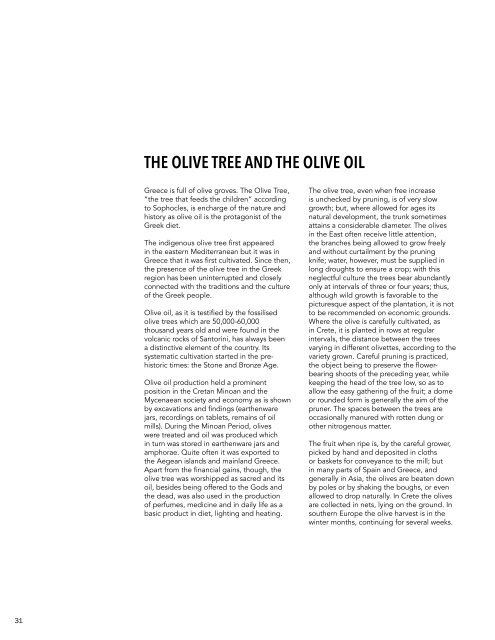Panoramic Magazine
Panoramic Magazine is a travel magazine which chooses a specific region of the world each year to feature each year. It is image heavy to further emphasise the beauty of each place. This year's region is The Mediterranean and this specific issue covers Greece. All the images that appear in the magazine were shot by me in 2014.
Panoramic Magazine is a travel magazine which chooses a specific region of the world each year to feature each year. It is image heavy to further emphasise the beauty of each place. This year's region is The Mediterranean and this specific issue covers Greece. All the images that appear in the magazine were shot by me in 2014.
Create successful ePaper yourself
Turn your PDF publications into a flip-book with our unique Google optimized e-Paper software.
THE OLIVE TREE AND THE OLIVE OIL<br />
Greece is full of olive groves. The Olive Tree,<br />
“the tree that feeds the children” according<br />
to Sophocles, is encharge of the nature and<br />
history as olive oil is the protagonist of the<br />
Greek diet.<br />
The indigenous olive tree first appeared<br />
in the eastern Mediterranean but it was in<br />
Greece that it was first cultivated. Since then,<br />
the presence of the olive tree in the Greek<br />
region has been uninterrupted and closely<br />
connected with the traditions and the culture<br />
of the Greek people.<br />
Olive oil, as it is testified by the fossilised<br />
olive trees which are 50,000-60,000<br />
thousand years old and were found in the<br />
volcanic rocks of Santorini, has always been<br />
a distinctive element of the country. Its<br />
systematic cultivation started in the prehistoric<br />
times: the Stone and Bronze Age.<br />
Olive oil production held a prominent<br />
position in the Cretan Minoan and the<br />
Mycenaean society and economy as is shown<br />
by excavations and findings (earthenware<br />
jars, recordings on tablets, remains of oil<br />
mills). During the Minoan Period, olives<br />
were treated and oil was produced which<br />
in turn was stored in earthenware jars and<br />
amphorae. Quite often it was exported to<br />
the Aegean islands and mainland Greece.<br />
Apart from the financial gains, though, the<br />
olive tree was worshipped as sacred and its<br />
oil, besides being offered to the Gods and<br />
the dead, was also used in the production<br />
of perfumes, medicine and in daily life as a<br />
basic product in diet, lighting and heating.<br />
The olive tree, even when free increase<br />
is unchecked by pruning, is of very slow<br />
growth; but, where allowed for ages its<br />
natural development, the trunk sometimes<br />
attains a considerable diameter. The olives<br />
in the East often receive little attention,<br />
the branches being allowed to grow freely<br />
and without curtailment by the pruning<br />
knife; water, however, must be supplied in<br />
long droughts to ensure a crop; with this<br />
neglectful culture the trees bear abundantly<br />
only at intervals of three or four years; thus,<br />
although wild growth is favorable to the<br />
picturesque aspect of the plantation, it is not<br />
to be recommended on economic grounds.<br />
Where the olive is carefully cultivated, as<br />
in Crete, it is planted in rows at regular<br />
intervals, the distance between the trees<br />
varying in different olivettes, according to the<br />
variety grown. Careful pruning is practiced,<br />
the object being to preserve the flowerbearing<br />
shoots of the preceding year, while<br />
keeping the head of the tree low, so as to<br />
allow the easy gathering of the fruit; a dome<br />
or rounded form is generally the aim of the<br />
pruner. The spaces between the trees are<br />
occasionally manured with rotten dung or<br />
other nitrogenous matter.<br />
The fruit when ripe is, by the careful grower,<br />
picked by hand and deposited in cloths<br />
or baskets for conveyance to the mill; but<br />
in many parts of Spain and Greece, and<br />
generally in Asia, the olives are beaten down<br />
by poles or by shaking the boughs, or even<br />
allowed to drop naturally. In Crete the olives<br />
are collected in nets, lying on the ground. In<br />
southern Europe the olive harvest is in the<br />
winter months, continuing for several weeks.<br />
31



